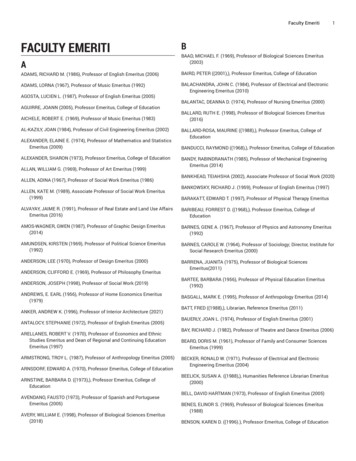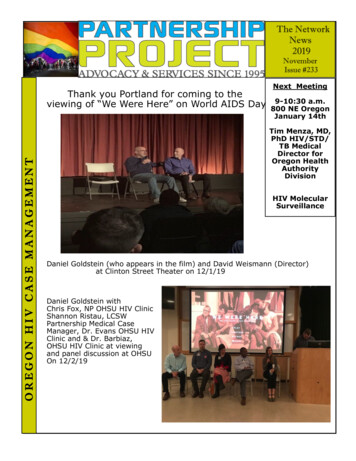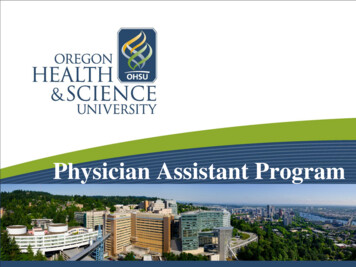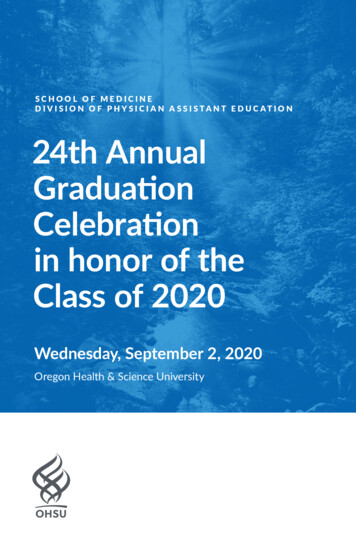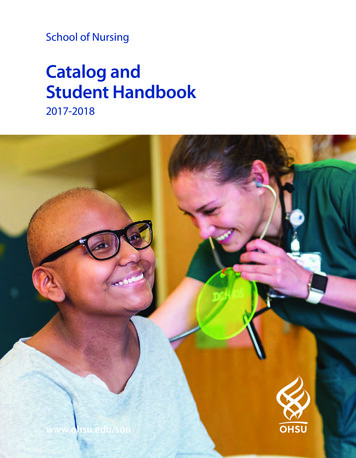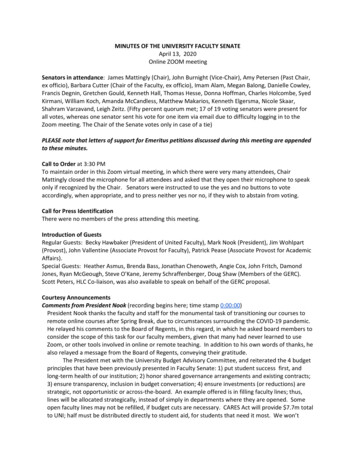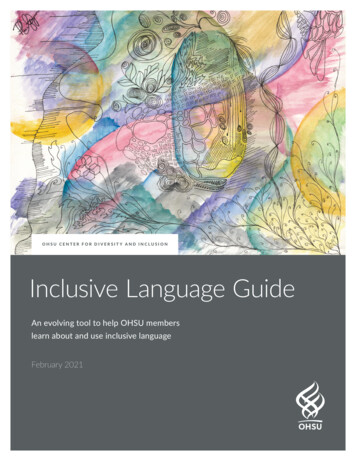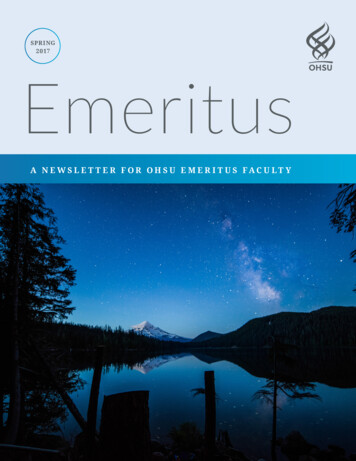
Transcription
SPR ING2017EmeritusA N E W S L E T T E R F O R O H S U E M E R I T U S FAC U LT Y
Emeritus Faculty News is published intermittently. This issue covers the fall2016 and spring 2017. Its purpose is to keep emeritus faculty informed aboutgrowth and other changes at OHSU. Items of interest should be sent to MaryAnn Lockwood by email at lockwood@ohsu.edu.Sources for the material in Emeritus are many including OHSU news releases,electronic newsletters and blogs, printed material and local media reports.2EMERITUS A N E W S L E T T E R F O R O H S U E M E R I T U S FA C U LT Y
NEWSBRIEFSThe Medical Research Foundation recognized twoOHSU scientists at its 2016 awards dinner: StevenBack, M.D., Ph.D., director, Pediatric Brain InjuryResearch Laboratory, Doernbecher Children’sHospital, and Richard L. Stouffer, Ph.D., seniorscientist and former chief of the Division ofReproductive and Developmental Sciences, andprofessor of Obstetrics and Gynecology, andPhysiology and Pharmacology. Dr. Stouffer is alsothe primate center director of the NIH-sponsoredand newly named National Center for TranslationalResearch on Reproduction and Infertility.Patricia Flatley Brennan, R.N., Ph.D., directorof the National Library of Medicine, visited OHSUin the fall to celebrate the 25th anniversary of theBICC. She outlined her vision for the third centuryof the National Library of Medicine.Phillip Marucha, D.M.D., Ph.D., dean of the OHSUSchool of Dentistry, announced that “we havesuccessfully completed the capital campaign forour new home. I would like to express my sincerethanks to each and every one of the 741 corporateand individual donors who have made thismagnificent building possible.”W W W.OHSU. EDUOHSU Healthcare has created a new division,Hospital Dental Services, which will managethe oral health needs of hospital patients. OHSUChief Medical Officer Charles Kilo, M.D., M.P.H.,and School of Dentistry Dean Phillip Marucha,D.M.D, Ph.D., jointly announced the new division,which will operate three clinic areas: PediatricDentistry in Doernbecher Children’s Hospital, Oraland Maxillofacial Surgery in Hatfield ResearchCenter and the newly reinstated General PracticeResidency in the Hatfield Research Center. TheGeneral Practice Residency will concentrate onadults, with a special focus on medically complexand special needs patients. The new division isheaded by Sean Benson, D.D.S., who recentlyassumed the position of clinical service chief aswell as associate dean of dental services in theSchool of Dentistry.At OHSU, Interprofessional Education (IPE) hasbecome a university-wide initiative that aims todrive an educational revolution producing teambased, patient-centered care that includes allspecialties. The School of Dentistry has taken thisinitiative to heart, incorporating IPE into manyprograms, the most visible being very activestudent rotations at OHSU’s rural health campuses.OHSU’s IPE curriculum will include electives andmultiprofessional courses as well as experiencesin the interprofessional simulation center. Furtheradvanced curriculum will focus on clinicalpractice and interprofessional collaboration. IPE ishelping to reinforce the link between oral healthand systemic health while overcoming some ofdentistry’s separation from medical care.3
The old School of Dentistry facility on the OHSUcampus will soon be dismantled. The buildingcame into service in 1956, uniting the state’s dentalschool with OHSU’s School of Nursing and Schoolof Medicine. Today the building is in the midstof a two-year demolition project. Over the nextfew months, the interior work will be completedand the more dramatic structural demolition willtake place. The institutional long-term master planslates the majority of the old school’s footprint formuch-needed hospital clinical space, but in the nearfuture, construction will begin at the east end of theparcel for the new Elks Children’s Eye Clinic, withgroundbreaking tentatively scheduled for 2017.In January, Governor Kate Brown visited theOHSU Cascades East Family Medicine ResidencyProgram in Klamath Falls to emphasize theimportance of the Oregon Health Plan.In late November, the OHSU Department ofAnesthesiology and Perioperative Medicine, theSchool of Medicine and the OHSU-PSU School ofPublic Health hosted Brian Williams, M.D., F.A.C.S.,associate professor of surgery, UT SouthwesternMedical Center and trauma surgeon at ParklandMemorial Hospital, to contribute to a growingcampus dialogue about race, encouraged bystudents and faculty. Dr. Williams was on duty4EMERITUS when police officers, shot after a peaceful BlackLives Matter protest July 7, came into his emergencydepartment. The event catalyzed his need to speakpublically about racism at a crucial moment inhistory. Hundreds of students, faculty and staffpacked campus auditoriums three days in a rowto listen as Dr. Williams shared his experiencessince boyhood that shaped his frame of mind on thenight of the mass casualty in Dallas. It was a nightthat – after 47 years of deflecting race-based microaggressions, exceeding expectations to achieveevery trapping of success and working feverishlyto save mortally injured police officers – left himagainst the wall in a deserted hospital hallway, headin hands, crying, a night that led him to speak upduring a news conference four days later because hecould no longer stay silent. “The root of all of this isthat there is a lack of open and honest discussionsabout racism in this country,” Dr. Williams said. “Itis not enough to be a good person if you are silent inthe face of social injustice.”The Portland Business Journal ranked OHSU asthe most admired health care company in Oregonand the third most admired overall. DoernbecherChildren’s Hospital and the Knight Cancer Institutecame in third and ninth, respectively, in the healthcare category. OHSU inched up a spot from lastyear’s ranking and is grouped with other top localcompanies, including Nike and Columbia Sportswear.A N E W S L E T T E R F O R O H S U E M E R I T U S FA C U LT Y
The U.S. Department of Defense has awardeda contract to the University of Pittsburgh incollaboration with OHSU and University ofColorado that could lead to 90 million in researchover the next decade to improve trauma care forboth civilians and military personnel. The first 10.8 million project aims to create a nationwidenetwork of trauma systems and centers capableof conducting detailed research to improve injurycare. “This unique collaboration has the potential tomake historic changes in how trauma patients aremanaged in both military and civilian settings,” saidMartin A. Schreiber, M.D., principal investigator,professor of surgery, and chief, Trauma, Critical Careand Acute Care Surgery Division at OHSU.197 physicians, nurse practitioners and physicianassistants from OHSU made it onto PortlandMonthly magazine’s top Doctors & Nurses 2017 list.This year was the first time in the list’s 13-yearhistory for physician assistants to be included.Last year, OHSU launched a new university-wideinitiative to better support the diverse healthneeds of rural Oregonians. The OHSU Campusfor Rural Health, with academic headquarters inKlamath Falls, is comprised of distributed learningsites around the state where OHSU medical, dental,nursing, pharmacy and physician assistantstudents live and learn together. Students gainvaluable interprofessional experiences in ruralclinical settings while immersing themselvesin local health issues by participating in alongitudinal community-based project. The currentsites are Klamath Falls and Coos Bay. OHSU isexploring possibilities for a new site elsewherein the state. “Studies show that exposing morestudents to rural areas will directly affect howmany people go into rural practice”, said JoyceHollander-Rodriguez, M.D., regional associatedean at the Klamath Falls site.OHSU, Adventist Health, Legacy Health andKaiser Permanente came together to celebrate theopening of the Unity Center for Behavioral Health.The unprecedented partnership consolidatesexisting behavioral health units of the partnerorganizations and adds a new psychiatricemergency treatment center.W W W.OHSU. EDU5
THE MARK RICHARDSONINTERPROFESSIONALSIMULATION CENTEROn Feb. 7, family members, colleagues andfriends of the late Mark Richardson, M.D., M.Sc.B.,M.B.A., met for a dedication ceremony honoringthe former School of Medicine leader. The MarkRichardson Interprofessional Simulation Center atthe Collaborative Life Sciences Building (CLSB) isnow a permanent fixture in one of Oregon’s mostdistinct education research buildings and onethat recognizes Dr. Richardson’s commitment totransforming medical education at OHSU. “TheCLSB and the Simulation Center were built underMark’s leadership, and they embody his belief inthe aspirations and abilities of young men andwomen who desire to be doctors,” said John Hunter,M.D., F.A.C. S., interim dean, School of Medicine.The ceremony was opened by OHSU President JoeRobertson, M.D., M.B.A., who called simulationthe cornerstone of education. “We will rememberMark every time we enter the center,” he said.6EMERITUS “Mark understood that having the specializedspace and equipment to practice the skills andart of medicine is essential to learning one ofhumankind’s most important professions.”Suzy Funkhouser, M.D., student in the class of2017, called Dr. Richardson a “tireless advocate forstudents.” Ms. Funkhouser told stories of workingwith him during her career as a lobbyist for OHSUand later, as a medical student.The 20,000-square-foot simulation center is astate-of-the-art facility that supports a full rangeof simulation education, training and researchevents. Health professions students from anumber of OHSU programs, as well as health careprofessionals from around the nation, utilize it forunique and cross-disciplinary training.A N E W S L E T T E R F O R O H S U E M E R I T U S FA C U LT Y
Directline:ORGANIZEDTO FULFILLOUR MISSIONJoseph E. Robertson, Jr., M.D., M.B.A.OHSU PRESIDENTWith the tragic passing of MarkRichardson and the retirement ofJenny Mladenovic, OHSU is currentlyexperiencing a leadership transition. I have fullconfidence in John Hunter, the Interim Dean ofthe School of Medicine, and Elena Andresen, theInterim Provost — as well as Tim Goldfarb, theInterim CEO of OHSU Healthcare. I also haveconfidence in each of you. I know that transitionscan lead to uncertainty but I want everybodyat OHSU to know that you are empowered tokeep doing the work you’ve been doing. We willnot curtail any initiatives begun under Drs.Richardson or Mladenovic. We are grateful forthe enormous contributions made by Mark andJenny and will continue to invest in initiatives theylaunched.You should also know that for some time now myexecutive team and I have been gathering andreviewing information about best organizationalpractices among our peer academic health centers.As OHSU grows and increases in complexity, andas external scrutiny and regulation increase, weneed to be certain that we are optimally organizedto meet challenges and advance our mission ina changing world. Mark and Jenny were bothW W W.OHSU. EDUinvolved in this process and made significantcontributions to the conversation. In the end, wecollectively embraced a few steps we could take toimprove OHSU’s effectiveness and thereby advanceour mission: 1) free mission leaders up to lead themissions; 2) better integrate within each missionand across missions; and 3) adjust administrativeportfolios to optimize efficiency and effectiveness.We have already begun the process of recruitingthe permanent Dean for the School of Medicine.We aim to recruit a Dean who will have significantstanding across research, education, clinicalpractice, physician alignment and communityintegration. The next Dean will also be a leader bewho can make clinical faculty the epicenter of theexpanding health system created through OHSUPartners while fostering the continued growthof School of Medicine education and researchprograms.To promote research alignment, we will create aChief Scientific Officer (CSO) position. Discussionshave begun with the Research Strategic AdvisoryCouncil, the Basic Science Council and othermembers of the scientific community on campus toflesh out the role and the characteristics we want7
in our next leader. I expect to continue to refinethe position over the next few months and begin anational search as we move to the final phases ofthe recruitment of our next Dean.Moving forward, as the education enterprisecontinues to grow in terms of students, programsand campuses — including the Campus for RuralHealth — we will focus the Provost’s positionmore sharply on the education mission. Similar tothe CSO, I am seeking faculty input both as to theparticulars of the role as well as the qualities wewill seek in the recruitment process. The nationalsearch will likewise be launched as we get to thefinal phase of our Dean recruitment.At its heart, OHSU is a mission-driven organization.Our mission drives everything we do: theprograms and services we offer, our partnershipstrategy, our need to be the gold standard ofinstitutional integrity — even how we organizeourselves administratively. I believe these changeswill help us advance our mission. Rest assured wewill continue to communicate about leadershiprecruitments in this time of transition.In the meantime, thank you for everything you dofor OHSU.8EMERITUS A N E W S L E T T E R F O R O H S U E M E R I T U S FA C U LT YWhat is a Provost?At a recent Faculty Forum attendees askedabout the role of the provost at OHSU. Sincethe institution is currently searching fora new provost we thought we’d include adescription of the provost’s duties at OHSU asa refresher.The provost is typically the chief academicofficer of a university, but the details of thisrole vary depending on the institution. Thecurrent interim Provost is Elena Andresen,Ph.D. and David Robinson, Ph.D. is executivevice provost. At OHSU, the provost overseesacademic components that are beyond thescope of individual schools; for example,accreditation, program approval and ongoingreview, and oversight of faculty and studentpolicies. The provost is also responsiblefor student services such as the registrar,financial aid, student access, student life,and institution-wide services such as theOHSU Library, the teaching and learningcenter, educational communications, andimmigration services. At OHSU, the provostalso oversees the schools of public health,nursing, dentistry, and pharmacy, as wellas initiatives such as interprofessionaleducation and the campus for rural health.
OHSU RESPONDSThe presidential election has brought a lot of uncertainty to the nation and to OHSU’s community. While we normally onlyinclude one Directline in each issue of Emeritus, we felt it was important to include excerpts from a few that directly addressOHSU’s commitment to Respect for All.Response to the electionHoliday messageThis week’s presidential election has caused a senseof vulnerability and concern about the future.The heated and, too often, hateful rhetoric thatpunctuated the campaign season has made theresults of this election feel very personal for many.I believe that the vast majority of Americans stillsupport fairness and equality, and I believe thesefundamental values will prevail. In this moment,complacency is not an option — but neither isdespair. OHSU is committed to an inclusive culturethat is safe and creates a respectful and healthyenvironment for all. We do this for those we serve,and for ourselves, as well as to demonstrate thepower of hope and perseverance for individualsand communities fearful of whether tolerance hasa place in the current political climate. Providing abeacon of hope and valuing one another across ourdifferences is more important than ever.We are a community of people dedicated to healing— and sometimes that includes healing each other.We need to learn from this experience and help eachother and our community to engage in healing andhealthy dialogue. Part of the healing process mustinvolve taking positive action.The results of this week’s election have also leftmany of us thinking about the future of healthcare in our nation and the impact on our mission ofimproving the health of all Oregonians. I can assureyou that we will continue to work with state andfederal leaders to advocate for the quadruple aimand for access to health care for all.There may be changes to public policy that impactthe work we do. As these proposals are detailedin the coming weeks, we will have additionaldiscussions about what this means for ourinstitution. In the meantime, let’s continue theimportant work that we are doing today.In this time of change and disruption, I encourage eachof you to take time for yourself, your family and findstrength in how we serve and care for one another.W W W.OHSU. EDUOHSU’s discoveries, patient care and teachingare offered for the benefit of all. OHSU is a safe,respectful and welcoming place for people ofall ages, cultures, abilities, ethnicities, genders,national origins, races, colors, religions, sexualorientations and ideas. Discrimination has no placeat OHSU and will not be tolerated. These principlesare embedded in the OHSU culture, but we mustredouble our commitment and raise our voice sothat others may hear. All are welcome at OHSU.Recently, for example, we have had a rise in thenumber of reports of patients requesting to optaway from a specific provider based on race,ethnicity or creed. I want to be very clear: we willnot honor such patient requests. I am committedto the fundamental principle of equity and nondiscrimination. Our job is to care and cure andnot to judge. We will treat all regardless of bias orbigotry, but we will not let them impose their valuesupon us. We must rise above.9
Response to travel banRestrictions on travel and immigration arecreating a climate of fear that is toxic even for thosenot directly impacted. All of us in academia haveinternational friends, family members, colleaguesor collaborators who may be affected, or who mayfeel they are next. We value all, regardless of race,ethnicity and/or nationality. We also value a freeexchange of ideas, made stronger by the inclusionof diverse perspectives representing many culturesand creeds. OHSU is aligned with the Association ofAmerican Universities in supporting immigrationpolicies that “prevent entry by those who wish toharm us, while maintaining the flow of talent thathas contributed so much to our nation.”At its heart, OHSU is a people organization. Weare a group of diverse, talented and committedindividuals working towards a common mission. Tofurther our work, we recruit from every corner ofthe globe. We seek the best minds to wrestle withthe toughest problems and we do so for the benefitof humanity. In our efforts to end cancer, stop HIV,beat heart disease, transform brain health, endblindness and treat kids and families, we cannotafford to ignore the contributions of any individual,no matter where he or she is from, no matter thecolor of their skin or what religion they practice.We recruit on a global scale. We partner on a globalscale. We compete on a global scale, and we serve ona global scale.Please be assured that OHSU will continue to monitorthis situation closely and take appropriate action toprotect faculty, staff, students, trainees and visitors.In the meantime, please know that while we are dutybound to follow the law, OHSU will not facilitate orcooperate with immigration enforcement activities.We will not share with the federal governmentconfidential student, patient or employee informationrelated to immigration status. The OHSU Departmentof Public Safety will not act on behalf of the federalgovernment to enforce immigration laws.10EMERITUS Convocation 2017Sunday, June 4, 2017 1p.m.O REG O N CO N V ENTI O N CENTERThe speaker for the all-OHSU convocationwill be Carolyn Clancy, M.D., Deputy UnderSecretary for Health for OrganizationalExcellence, Veterans Health Administration.Dr. Clancy oversees the agency’s performance,quality, safety, risk management, systemsengineering, auditing, oversight, ethics andaccreditation programs. Additionally, sheserves in a direct consultative capacity tothe Under Secretary for Health, servingas a national subject matter expert in herdirectorate. Dr. Clancy, a general internistand health services researcher, is a graduateof Boston College and the University ofMassachusetts Medical School. She holds anacademic appointment at George WashingtonUniversity School of Medicine; serves as SeniorAssociate Editor, Health Services Research andis a member of the Institute of Medicine.A N E W S L E T T E R F O R O H S U E M E R I T U S FA C U LT Y
RESEARCHREPORTSA breakthrough study by OHSU scientistsdemonstrates, for the first time, a mechanismthat prevents the formation of new neurons inold brains. The discovery provides a new path forinvestigation that may lead to the prevention—and potentially the reversal—of age-relateddementia by promoting the formation of neuronsand preventing their decline. The production ofneurons drops dramatically during aging, andthe brain slows down. New reports continue toemerge that suggest—but do not prove—thatstrong social networks, learning a language,healthy diets, and exercise may slow the brain’sdecline. These all contribute to overall health,but no cure has been found for age-relatedcognitive decline or the decreasing production ofneurons. The new study, published Jan. 31 onlinein the Journal of Biological Chemistry, was led byLarry Sherman, Ph.D., a senior scientist in theDivision of Neuroscience at the Oregon NationalPrimate Research Center. The lead author ofthe study, staff scientist Weiping Su, Ph.D., hasworked with Sherman on previous research onneurodegenerative disorders.W W W.OHSU. EDUCosmic radiation during deep space travel couldalter the cognitive function and behavior ofastronauts on an extended mission — such as atrip to Mars. Exposure to this radiation may beunavoidable for astronauts on any future mission toMars. Results of a study led by Jacob Raber, Ph.D.,professor of behavioral neuroscience in the Schoolof Medicine, recently published in the journalBMC Genomics suggest that long-term exposure tocosmic radiation, particularly to Iron-56 ions, couldcause symptoms ranging from memory problems toimpaired judgment. Moreover, these effects couldbe long-lasting and perhaps without resolve. Betterunderstanding the underlying mechanisms couldhelp scientists find ways to monitor and protectastronauts from cosmic radiation in future deepspace missions and lead to the development ofpotential treatment options.No treatments exist for children born withmitochondrial diseases, but a series of discoveriesin the OHSU Center for Embryonic Cell and GeneTherapy is making progress on a techniquethat prevents transmission of these often-fatalgenetic diseases, which are passed on frommothers to their children. The latest findingswere published Nov. 30 in the journal Nature.OHSU scientist Shoukhrat Mitalipov, Ph.D., leda team that successfully prevented transmissionof genetic defects in mitochondrial DNA in thecells of monkeys in 2009 and in human cells in11
2012. Mitochondrial mutations cause a rangeof diseases, many of which affect organs withhigh-energy demands such as the heart, muscleand brain. Currently, the U.S. government forbidsclinical trials of mitochondrial replacementtherapy. Britain has authorized such studies.The first baby treated with mitochondrialreplacement therapy was born in Mexico in 2016.The anti-inflammatory and anti-plateletproperties of aspirin have made it the subjectof intensive investigation for over a century.More recently, aspirin use has been correlatedwith reduced long-term risk of some cancers,particularly colorectal cancer. The reasonsremain unknown, as does the degree to whichthe effect comes from direct inhibition of cancer12EMERITUS cells and how much is due to inhibition ofplatelet activation and function. A study recentlycompleted by a team of OHSU researchers andpublished in the American Journal of PhysiologyCell Physiology suggests the benefit of aspirin maybe due to its effect on platelets rather than actingdirectly on tumor cells. In a series of experimentswith cultured cells, a team led by Owen McCarty,Ph.D., chair of the Department of BiomedicalEngineering in the School of Medicine, showedthat inhibition of platelets with low doses ofaspirin cuts the signaling link between plateletsand some cancer cells, which in turn knocks backcancer growth. It is not yet known whether thecascade of effects observed in cell cultures worksthe same way in people.A N E W S L E T T E R F O R O H S U E M E R I T U S FA C U LT Y
In most of the human body, the lymphaticsystem clears away waste and toxins. Thebrain, however, has no lymphatic vessels. Itswaste, including plaques associated withAlzheimer’s disease, is cleaned instead bycerebrospinal fluid recirculating through braintissue. Over the course of five years, research inthe lab of Jeffrey Iliff, Ph.D., has defined thisbrain-wide paravascular pathway, called theglymphatic system. Iliff’s team has found thatthis recirculation is modulated by sleep andalso that, as the brain ages, this waste-clearingprocess is impaired. Their work continues toinvestigate what causes the glymphatic system toslow. In research findings published Nov. 28 inthe journal JAMA Neurology, Iliff demonstratesthe possible role of aquaporin-4, a membraneprotein in the brain and key component of theglymphatic system. The study suggests that futureresearch focusing on aquaporin-4 might find it tobe a useful target for potentially preventing andtreating Alzheimer’s disease.In 2001 the U.S. Food and Drug Administrationgranted priority review for imatinib mesylate,sold under the name Gleevec , as an oral therapyfor patients with chronic myeloid leukemia,or CML. The New England Journal of Medicinepublished results from a nearly 11-year followup study, which showed an estimated overallsurvival rate of 83.3 percent. According to theNational Cancer Institute, prior to Gleevec’s 2001FDA approval, fewer than 1 in 3 CML patientssurvived five years past diagnosis. Brian Druker,M.D., who led the original clinical developmentof Gleevec, co-authored the study. The worldwidestudy enrolled 1,106 participants at 177 cancercenters in more than 16 countries. “The longterm success of this treatment confirms theremarkable success we’ve seen since the veryfirst Gleevec trials,” said Druker, director of theOHSU Knight Cancer Institute, a Howard HughesMedical Institute Investigator and JELD-WENW W W.OHSU. EDUChair of Leukemia Research in the School ofMedicine. “This study reinforces the notion thatwe can create effective and non-toxic therapies.”The discovery of Gleevec ushered in the era ofpersonalized cancer medicine, proving it waspossible to shut down cells that enable cancer togrow without harming healthy ones.A research team at OHSU is likely to help developa vaccine against the Zika virus, which has seenoutbreaks in South America and Southeast Asiaand also has turned up in Florida and Texas. Thestudy was conducted on male and female rhesusmacaque monkeys last year at OHSU’s primatecenter in Beaverton. Scientists followed thevirus as it spread from the bloodstream to othertissues. They found it attacked the central nervoussystem, reproductive and urinary tracts, muscles,joints and lymph nodes. But what surprised themthe most, said Dan Streblow, Ph.D., of OHSU’sVaccine and Gene Therapy Institute, is that thevirus persisted in tissue for at least five weeks,the length of the study for each animal. Zikausually causes mild symptoms in adults but canshrink the brain of a fetus, causing microcephaly.In severe cases, the children can end up witha lifelong host of problems, including seizures,developmental delays and hearing and vision loss.“We’re really interested in understanding howthe virus causes disease in humans,” Streblowsaid. The study, published in the journal PLOSPathogens, is likely to affect the vaccine researchunderway because scientists have focused onclearing the virus from the bloodstream. Now,they’ll have to ensure that the virus doesn’ttake hold in the central nervous system or othertissues, said principle author of the study, AlecHirsch, Ph.D.13
AWARDS ANDHONORSSomnath Saha, M.D., M.P.H., staff physician atthe VA Portland Health Care System and professorof medicine, School of Medicine, was selected bythe Association of American Medical Colleges forthe Hebert W. Nickens Award. He was honoredfor contributions to promoting justice in medicaleducation and health care equity in the U.S.Sancy Leachman, M.D., Ph.D., director of themelanoma research program in the Knight CancerInstitute, has been appointed the inauguralrecipient of the John D. Gray Endowed Chair inMelanoma.David Huang, M.D. Ph.D., Peterson Professorof Ophthalmology, professor of biomedicalengineering and director of the Center forOphthalmic Optics and Lasers, has receivedthe 2017 Fritz J. and Dolores H. Russ Prize forhis co-invention optical coherence tomography.The 500,000 National Academy of EngineeringPrize recognizes an outstanding bioengineeringachievement that improves the human condition.Seiko Izumi, Ph.D., R.N., assistant professor,School of Nursing was named a fellow inPalliative Care Nursing by the Hospice andPalliative Nursing Association.OHSU graduate students received nine of theThe Department of Comparative Medicine andOHSU has been awarded full accreditationfrom AAALAC (Association for Assessmentand Accreditation of Laboratory Animal Care),along with a commendation for providing andmaintaining an excellent program of laboratoryanimal care and use. OHSU was one of the first27 first-year scholar awards from AchievementRewards for College Scientists.universities to receive accreditation when theprogram was started more
Richardson and the retirement of Jenny Mladenovic, OHSU is currently experiencing a leadership transition. I have full confidence in John Hunter, the Interim Dean of the School of Medicine, and Elena Andresen, the Interim Provost — as well as Tim Goldfarb, the Interim CEO of OHSU Healthcare. I also have confidence in each of you.
